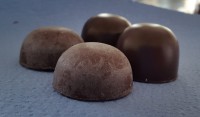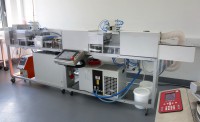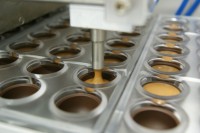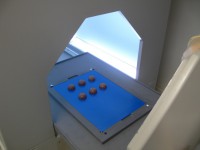Fraunhofer-Institut für Verfahrenstechnik und Verpackung IVV
Pralines without fat bloom – feasible solutions from the Fraunhofer IVV
Pralines are particularly susceptible to fat bloom formation due to fat migration from the filling into the chocolate shell. New forming technologies, higher production speed and the request for longer shell life by the retailers are challenges for research and practice.
By Isabell Rothkopf, Scientific Assistant at Fraunhofer IVV
Optimized processing and storage conditions lead to stable products – products that are free from fat bloom during the storage period. Fat bloom on pralines is a harsh disappointment for consumers and influences their future buying decision. Beside the immediate economic damage for the manufacturers, they have to identify the causes and secure the shelf life of the ongoing production. Various factors are of importance: raw material, composition, product design, process technology, production speed and storage conditions [Danzl & Rothkopf (2016); Ziegleder et al. (2010); Ziegleder (2012)]. Innovative forming technologies such as cold forming or one-shot enable new product designs, faster and thus more economic production for example, but an impact on fat bloom formation must always be considered.
The Fraunhofer Institute for Process Engineering and Packaging IVV in Freising/Germany has studied this topic for several years and works closely together with the chocolate industry, organized in the Industry Association IVLV for the most part, to do cooperative industrial research. The Fraunhofer IVV investigated different influencing factors and showed new possibilities – factors like the impact of forming technology [Ziegleder et al. (2010)], production speed [Ziegleder (2012)] and composition on fat migration and fat bloom as well as the potential fat bloom prevention by stabilizing the chocolate shell by milk fat addition [Ziegleder et al. (2011)] and which influence filling fats and oils introduced during the enrobing process might have [Rothkopf (2016)].
Versatile parameters must be regarded
In focus of present research are the storage conditions [Danzl & Rothkopf (2016); Rothkopf (2017)]. In a current project, the fat bloom stability of the particular susceptible whole nut chocolates is optimized. In this case, many factors have to be considered: the quality of the roasted nuts, chocolate tempering and the conditions during mixing and cooling.
Regarding the versatile parameters, it is crucial in which way the chocolates and pralines for the studies are produced. Considerable chocolate manufactures collaborated and produced pralines and filled chocolates in large-scale of several tons using different forming techniques (conventional shelling, cold forming, one-shot, enrobing) and in high speed, as is customary in industrial production. Thus, the results can be regarded as objective and relevant to practice.
Additionally, the Fraunhofer IVV has a pilot plant available, which enables the production of specific pralines using the different forming techniques. For instance, the unique praline manufacturing plant (PN-Y, Ubitec GmbH, Bergneustadt/Germany) is capable of producing both cold formed and one-shot pralines. Other technical equipment for tempering, enrobing, cooling and storage exists as well as modern measurement techniques for rapid product quality evaluation.
Accurate control of storage temperature
During storage, fat migration occurs in pralines, which means a notice-able transport of liquid filling components into the chocolate coating. Cocoa butter in small amounts is subsequently pushed to the surface, where it crystallizes as visible fat bloom. Disadvantageous interference of the mechanisms for migration and crystallization lead to fat bloom formation. This usually takes place in a certain temperature range, preferably in between 20 and 24 °C, but depends on the product. The amount of migration can be evaluated quickly using NMR nuclear magnetic resonance and to some extent DSC thermoanalysis and can be monitored during storage. For objective evaluation of fat bloom, the Whiteness Index can be determined using photometric analysis.
The faster the production and the shorter the time in the cooling tunnel, the higher is the risk of problems regarding the stability of the products [Ziegleder et al. (2010); Ziegleder (2012)]. Chocolate only resists the ingress of filling oil, if it is sufficiently crystallized. Conventional shelling gives enough time for stabilization during forming and cooling, since products are often stored before the shells are filled. Cold formed shells are cooled identically, but will be filled just after the cooling tunnel. The liquid chocolate and filling are in direct contact in the one-shot process, which causes mass exchange during manufacturing and increases the risk of fat bloom. This reveals the importance of production experiments under industrial conditions to make realistic statements on fat bloom problems.
Freshly produced pralines are instable and need accurate storage temperature control during the first hours. Further storage should be at a maximum temperature of 18 °C.
A warm post-tempering procedure of nougat filled dark chocolate for 2 h at 27 °C showed a delayed fat bloom formation, but at the expense of a soft chocolate shell. Temperature fluctuation, which might occur during transport and logistic, is simulated in cycled storage tests. Cycled storage is also used for fast estimation of shelf life. However, a comparison revealed that isothermal high temperatures lead to faster fat bloom formation than cycled storage [Rothkopf (2017)]. A current project focuses on the fast prediction of shelf life using accelerated storage tests for fat bloom development. •
Literature
Danzl W, Rothkopf I (2016): Storage conditions of filled chocolates – influences on fat bloom development. ZDS Chocotec, Köln.
Rothkopf I, Danzl W, Ziegleder G (2016): Proof and quantification of filling oils in chocolates from enrobers. New Food, 19(6), 48-52.
Rothkopf I, Schütz B, Danzl W, Ziegleder G. (2017): Comparison of isothermal and cycling temperature storage of filled dark chocolate products for accelerated shelf life prediction. Eur J Lipid Sci. Techn., will be just printed.
Ziegleder G, Danzl W, Hinterberger T, Mikle H. (2010): Haltbarkeit von Pralinen – Einfluss der Produktionstechnik. Süsswaren 7/8, 18-20.
Ziegleder G, Hinterberger T, Mikle H. (2011): Haltbarkeit von Pralinen/Fettmigration. Deutsche Molkerei Zeitung dmz 3, 16-18; /Fettreifbildung, dmz 4, 22-24; /Milchfett, dmz 15, 20-23.
Ziegleder G (2012): Fat migration and bloom – theory and practice. ZDS Chocotec, Köln.




